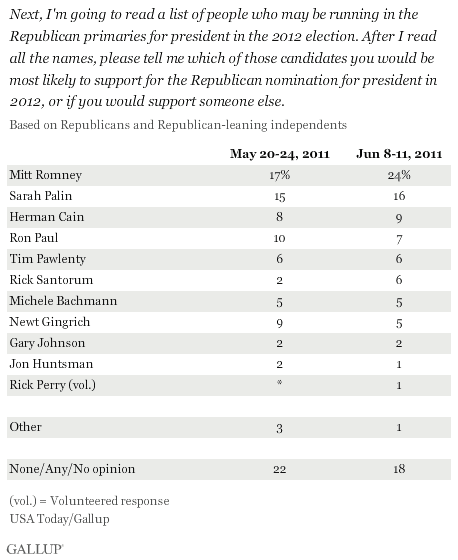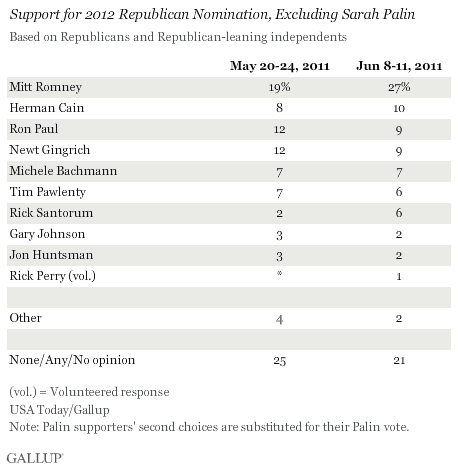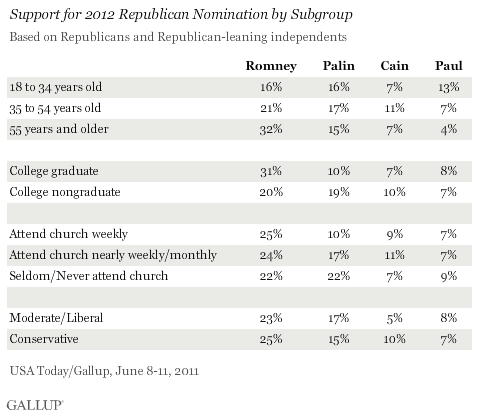PRINCETON, NJ -- Republicans' support for Mitt Romney as their party's 2012 presidential nominee has increased significantly to 24%, compared with 17% in late May. As a result, Romney has widened his advantage over Sarah Palin in the latest update on rank-and-file Republicans' nomination preferences.

These results are based on a June 8-11 USA Today/Gallup poll, conducted on the eve of a candidate debate in New Hampshire that will be the first to include some of the better-known candidates.
Romney appears to have gotten a boost in recent weeks after the official announcement of his candidacy. Gallup's prior update of May 20-24 came just after former co-leaders Mike Huckabee and Donald Trump announced they were not candidates for the nomination; that poll showed Romney and Palin in a virtual tie. Since then, Romney's support has increased and Palin's has been flat, leaving Romney with an eight-percentage-point advantage.
That is the largest numerical lead Gallup has measured for any candidate since it first began measuring nomination preferences in September. In that initial September poll, Romney held a seven-point advantage over the field of candidates. Romney or Huckabee held slim margins of no more than four points in subsequent polls.
No candidate besides Romney has shown a significant increase in support since the May update, though Rick Santorum, who also recently announced his official candidacy, saw his support rise from 2% to 6%. Meanwhile, support for Newt Gingrich, whose campaign has been off to a rocky start since his official announcement last month, is now at 5%, a slight decline since May. The high point for Gingrich was 13% in November.
Romney Has Wide Lead With Palin Excluded From Race
Palin's candidacy is far from assured, though her recent East Coast bus tour re-ignited talk of her joining the race. Should Palin not run, Romney would become a stronger front-runner. He holds a 17-point advantage over the nearest competitor, Herman Cain, when Palin's votes are excluded and re-allocated to her supporters' second choice. Under that scenario, six candidates essentially tie for second place with between 6% and 10% of the vote.

In May, Romney held a seven-point advantage over his nearest competitors in Republicans' preferences with Palin excluded from the race. His lead has expanded as his support has grown and that of the rest of the field has shown minimal change.
Romney Shows Strong Appeal to Older, Educated Republicans
Romney holds at least a slight advantage over his competitors among most Republican subgroups. However, he has particular strength among older Republicans and those with a college education. Additionally, he holds a wide lead among Republicans who attend church every week.
The leading candidates' support is generally similar by ideology.

Those patterns of support could serve Romney well in the primaries and caucuses, as they are groups that historically tend to vote at higher rates in elections.
Implications
Romney may be emerging as a front-runner in a GOP race that has been characterized to date by its lack of a leading candidate. Republican nomination contests usually have a clear front-runner, and that candidate often goes on to win. But that did not hold true in the last presidential election cycle, when Rudy Giuliani led in national preference polls throughout 2007 but performed poorly in the actual nominating contests in 2008. Additionally, even if Romney were to expand his lead into the double digits in the coming months, he still would rate as one of the weakest Republican front-runners in recent GOP nominating history.
Romney remains behind lesser-known candidates Cain and Bachmann in Gallup's measure of positive intensity toward candidates, though his score seems to be on the rise.
Whether Romney is actually assuming the mantle of the front-runner will be clear in future polls. The current results could be a short-term bounce due to increased attention paid to his campaign after his official entry into the race, or could indicate a more lasting shift in preferences that has put him in the top position in the GOP field.
Survey Methods
Results for this USA Today/Gallup poll are based on telephone interviews conducted June 8-11, 2011, on the Gallup Daily tracking survey, with a random sample of 851 Republicans and Republican-leaning independents, aged 18 and older, living in all 50 U.S. states and the District of Columbia.
For results based on the total sample of Republicans, one can say with 95% confidence that the maximum margin of sampling error is ±4 percentage points.
Interviews are conducted with respondents on landline telephones and cellular phones, with interviews conducted in Spanish for respondents who are primarily Spanish-speaking. Each sample includes a minimum quota of 400 cell phone respondents and 600 landline respondents per 1,000 national adults, with additional minimum quotas among landline respondents for gender within region. Landline telephone numbers are chosen at random among listed telephone numbers. Cell phone numbers are selected using random-digit-dial methods. Landline respondents are chosen at random within each household on the basis of which member had the most recent birthday.
Samples are weighted by gender, age, race, Hispanic ethnicity, education, region, adults in the household, and phone status (cell phone only/landline only/both, cell phone mostly, and having an unlisted landline number). Demographic weighting targets are based on the March 2010 Current Population Survey figures for the aged 18 and older non-institutionalized population living in U.S. telephone households. All reported margins of sampling error include the computed design effects for weighting and sample design.
In addition to sampling error, question wording and practical difficulties in conducting surveys can introduce error or bias into the findings of public opinion polls.
View methodology, full question results, and trend data.
For more details on Gallup's polling methodology, visit www.gallup.com.
